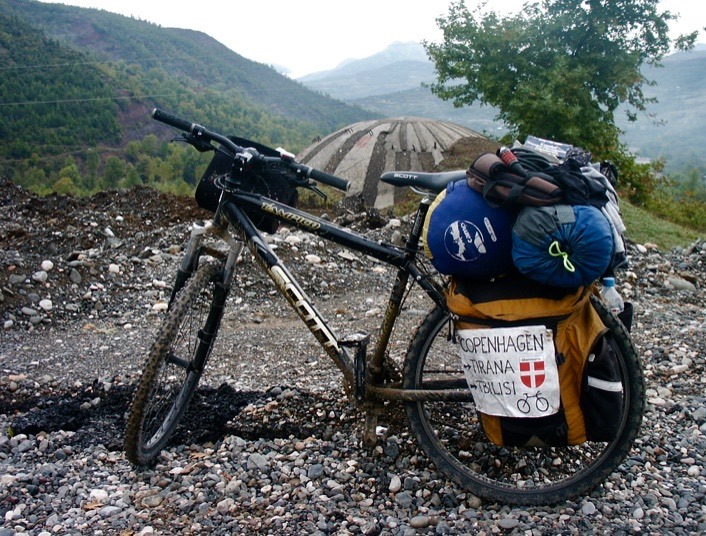
I cycled from Copenhagen to Tirana and Tbilisi.
Back in 2004, I spent 4 months cycling 6800 kilometers from Denmark to Tbilisi. My goal was to watch a couple of world cup qualifying football games between Denmark and Georgia. With a pitstop in Tirana on the way, to watch Denmark vs Albania.
I love to travel by bicycle. And I love to watch football games. So why not combine that? This is what I asked myself back in the summer of 2004. Denmark had just ended up in a very interesting world cup qualifying group, with a few exotic nations. Albania and Georgia were two of them.

At the starting point in Copenhagen, with my old friend Arne Runge.
So, on August 1st I set off from Copenhagen on my bicycle. The game between Denmark and Albania was mid October. So cycling to Tirana was my first goal. Cycling through Denmark and Germany was in many ways the easiest part, from a cycling perspective.
I had the time to stop in southern Denmark to watch the Tour of Denmark in cycling, in the town Åbenrå. Then I crossed the border into Germany, where I spent a couple of days in Hamburg.
1st game I saw was St Pauli vs Holstein Kiel.
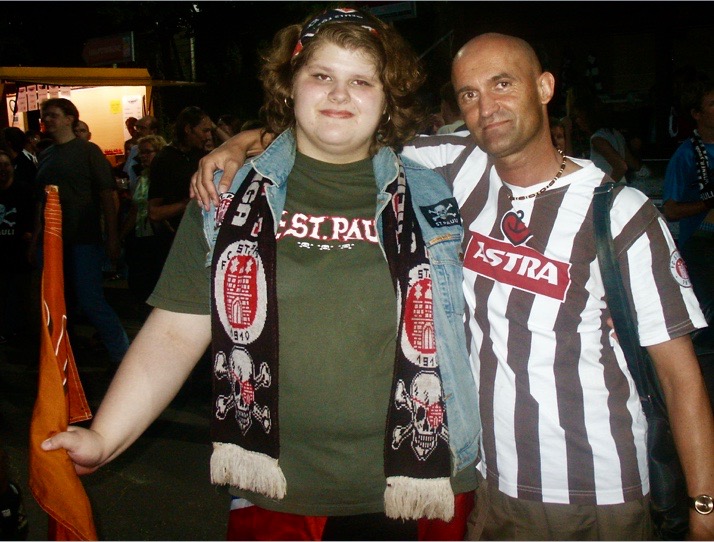
Friendly St Pauli fans.
Hamburg is home to FC St.Pauli. Not the biggest club in Hamburg. But a club that has become a cult club in the footballing world, because of the supporters, who are very colorful.
Many of the fans belong on the far left politically. Something that is a little unusual in the footballing world. There was punk rock music in the speakers before the game.
A reggae concert behind one of the goals after the game. The stadium was packed, even if St Pauli was only playing in the third league back then.
Eastern Germany was a bliss for a cyclist.
After Hamburg I cycled via Berlin, down through eastern Germany. If you are into rural cycling and visiting Germany, then I highly recommend the eastern part of the country. It’s not nearly as congested and industrial, as the western part of Germany.
Just make sure that you are not riding with thin tires, as there are quite a bit of cobblestones in the old towns in eastern Germany. Eastern Germany is in many ways a really nice place for cyclists though.
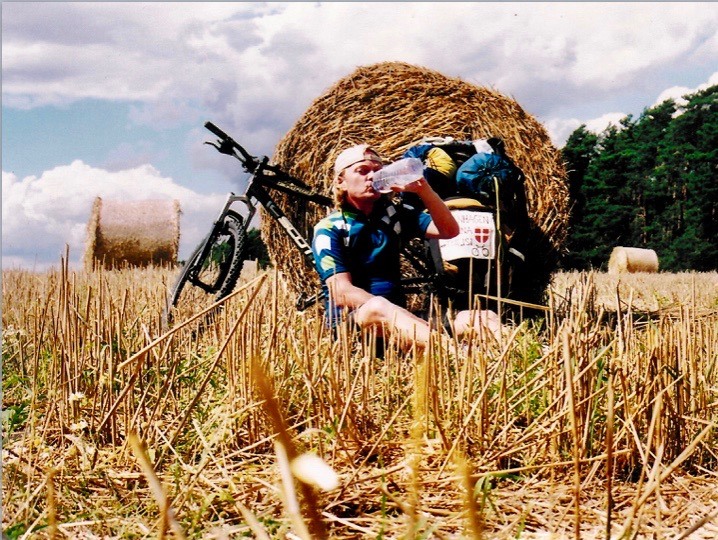
Taking a break in a field in East Germany.
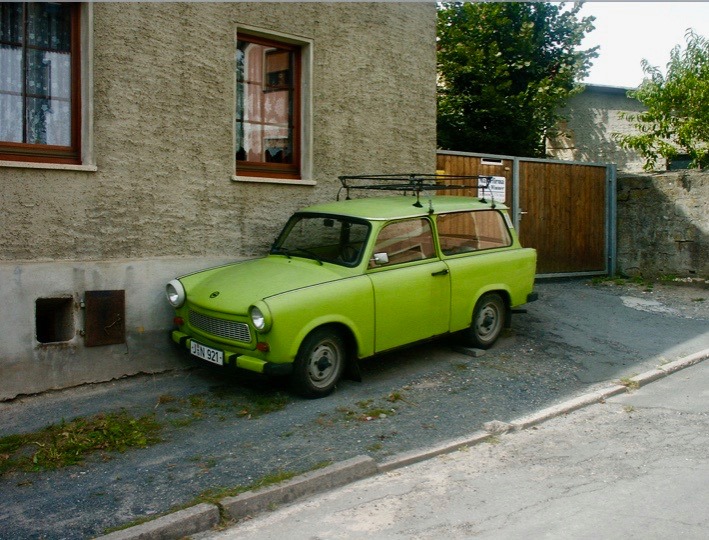
An old Trabant.
After a couple of days at Tegernsee in Bavaria, where I visited old friends. I hit the alps. In southern Bavaria, I had encountered some climbs where I had struggled a bit. So I was a little worried about cycling across the alps.
I entered Austria by Achensee and Zillertal and was surprised to see that it was actually quite flat cycling there. I learned that Austria consists of many valleys, where the cycling is mostly flat.
It’s getting from one valley to the next that tests your level of fitness. My first test was the Gerlos pass. That was 16 kilometers of cycling up, up and up. It was not that steep though. I managed it without too much struggle. That gave me confidence that it was not the mountains that would stop me on this trip. I cycled down to Badgastein, where I had to take a short train journey through a tunnel. As I was not allowed to cycle through the tunnel.
Then I was in the part of Austria called Carinthia. Carinthia is a very picturesque part of Austria.
But Slovenia was calling, so I headed up the Loibl Pass. Compared to the climbs I had within Austria, the Loibl pass was much harder. It was not as long a climb as Gerlos, having only 10 kilometers of climbing.
It was very steep though and really took a toll on me. When I reached the top of the climb, I found that there was a tunnel that I was not allowed to cycle through. Having just had one of the hardest climbs ever, I was not turning back though.
So after a bit of negotiating with the local custom officials, I was allowed to cycle through the tunnel. As long as I had a car riding next to me, with full light on. I was saved by two German hippies in an old van. They agreed to help me through the tunnel. Always nice to meet helpful people when on the road.

Austria is a fantastic country for cycling.
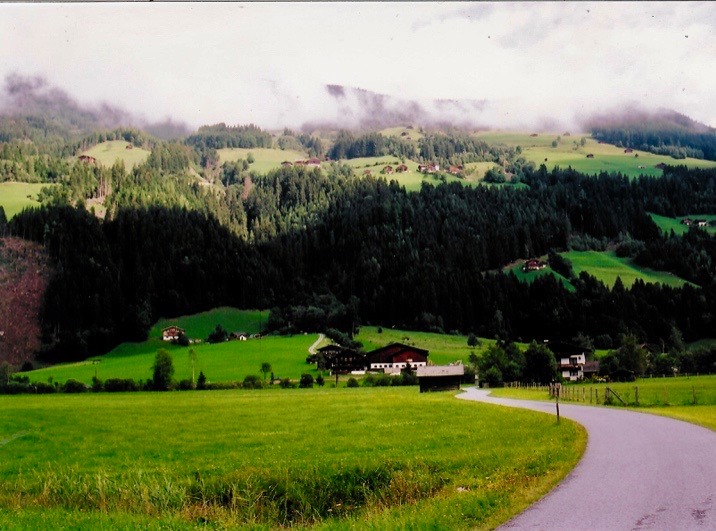
Nice bike path in Austria.
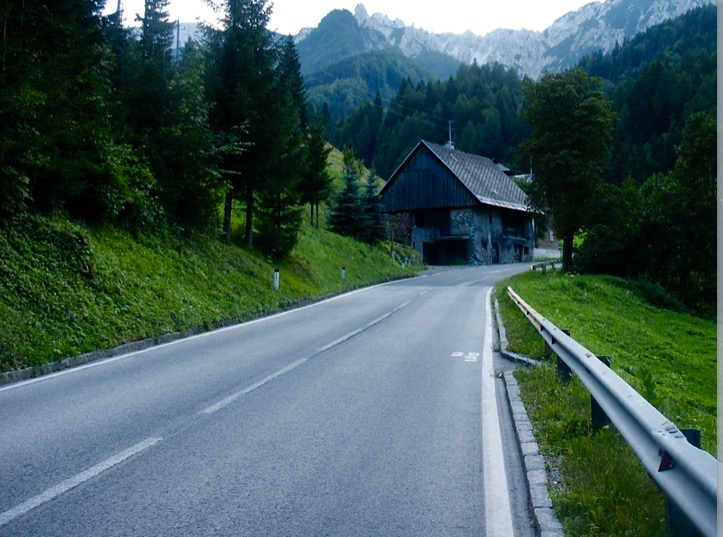
Cycling towards the Loibl pass.
Slovenia is one of my favourite countries.
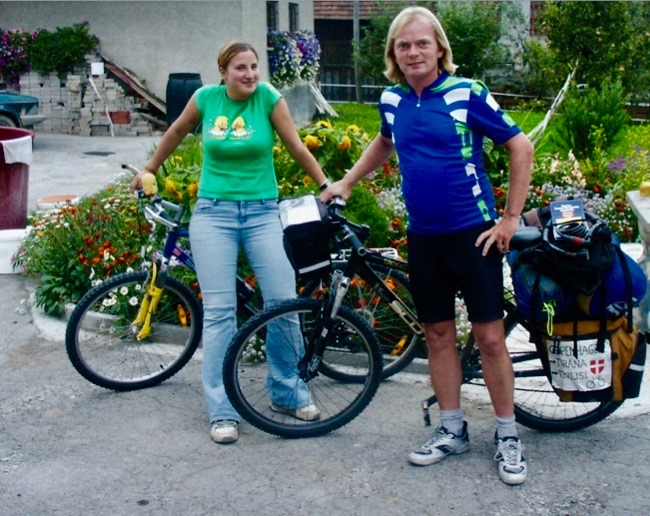
Visiting a good friend in Prekopa, Slovenia.
Coming into Slovenia was really nice. It looks quite a bit like Austria. But I find that people are a little more open minded towards a traveler there. Almost all Slovenians are multi lingual and quite well educated. So even when I stopped at small farms, the farmers would typically ask me whether I wanted to converse in Slovenian, English, German, or maybe even Italian.
I stopped over in nice towns, such as Ljubljana, Celje and Lasko before heading towards the Croatian border. This was where I had my only crash on the trip. I was heading down a mountain road and was probably cycling 30 kilometers per hour.
That was when I hit some gravel that I mistook for being asfalt. So I was sent flying over my handlebars and sprained both wrists, as I landed. Only my wrists and fingertips got injured though. And I had a small scratch on the knee. My fingers were injured in the way that I had no skin left on them. It was a little painful, but I continued after being bandaged up a little at a local roadside restaurant.
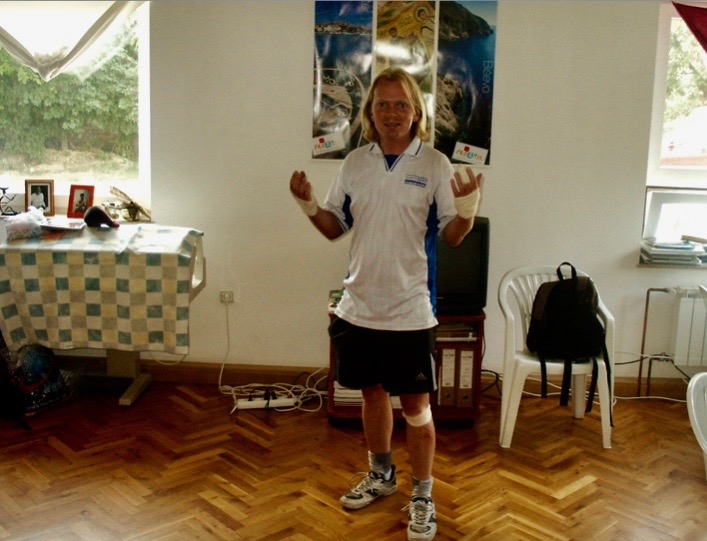
Sprained my wrists after a little crash in Slovenia.
Watching Croatia vs Hungary in Zagreb.
Arriving in Zagreb, I was invited for dinner by some friends. One of them was heading to a football game the next day between Croatia and Hungary. I decided right away to join her.
The game ended up being a fairly easy win by Croatia. The atmosphere was very intense. Ultra nationalism was in the air and I was happy that I was there with a local. As I had a few nasty stares from people who could see I was not Croatian. I was wearing a scarf from my local amateur football club in Denmark.
That attracted attention from several collectors among the Croatian crowd. I refused to take any payment for it and said that I would be happy to just exchange it with a local football scarf. And so I did with a guy standing next to me.
Two minutes later that scarf almost got me thrown out of the stadium. I was not aware that the scarf I was given had neo nazi slogans on it and was from the Croatian far right nationalist group Ustasche. But the police were very understanding when I explained how I got it. They just told me to find some better friends in the future.

Croatian fans at the Croatia vs Hungary game.
From Zagreb I cycled out to the coast of Croatia and headed down along the coast. Decided to go island hopping with my bike down the coast, as the coastal road in Croatia has a lot of traffic.
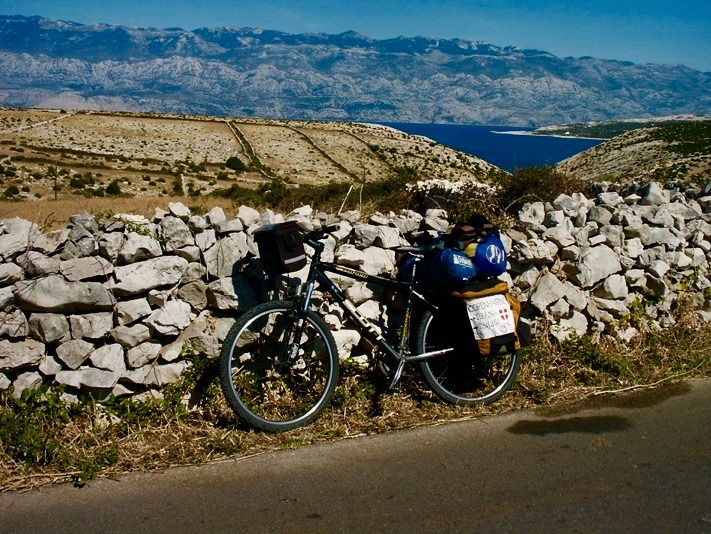
Cycling along the coast of Croatia.
Had a quick stop in Dubrovnik, which in 2004 already had way too many tourists. But a little south of Dubrovnik, I found a really nice campsite at a small village called Molunat. The owner was a sympathetic guy who told me how he had to flee during the Yugoslav civil war, as war ships attacked the coast where the campsite was. These days it’s a nice and tranquil spot that I would highly recommend over the crappy and overpriced campsite in Dubrovnik.
I ended up spending an extra night at the campsite by the way. When I cycled away from the campsite and crossed the border to Montenegro, I was quietly telling myself that I was happy that I did not have to climb the little mountain that divides Croatia and Montenegro again. But I had to climb it again, as I realised, right after climbing and descending from the pass, that I had forgotten my phone at the campsite. That gave the custom officials by the border the laugh of the day.
But my phone was still sitting with the charger in the plug, where I had left it at the campsite. Always nice to see that people do not take your stuff, just because you forget it for a few hours.
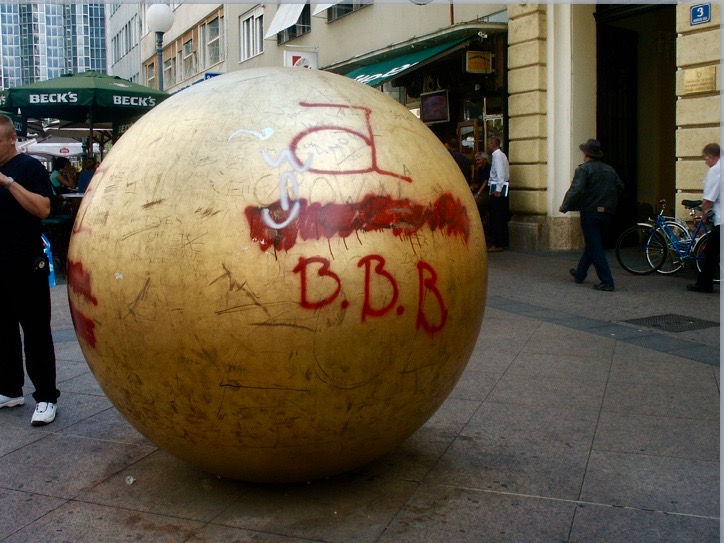
Croatian hooligan Graffiti in Zagreb.
In Montenegro I cycled past the bay of Kotor, which is some of the most amazing coastline you will ever come across. Make sure you treat yourself to a visit to this part of the world one day. I stopped for the night at a little cafe in the outskirts of Kotor. There was a sign saying that they had rooms for rent. I was shown a very nice room for a very reasonable price, by the teenage daughter of the house. She spoke fluent English, without an accent.
When I asked her how she learned her English, she told me that she had lived in Scotland. I assumed that she had been there as a refugee during the war. But when her father returned home in the afternoon, he told me that the reason why the family had lived in scotland was because he had played as a goalkeeper for Dunfermline. His name was Zoran Lemajić and he had also played for Sporting Lisbon and several other Portuguese clubs. Now that his playing career had ended, he was coaching back at home and running a little cafe with room for rent upstairs. Really nice encounter with a very hospitable footballer.
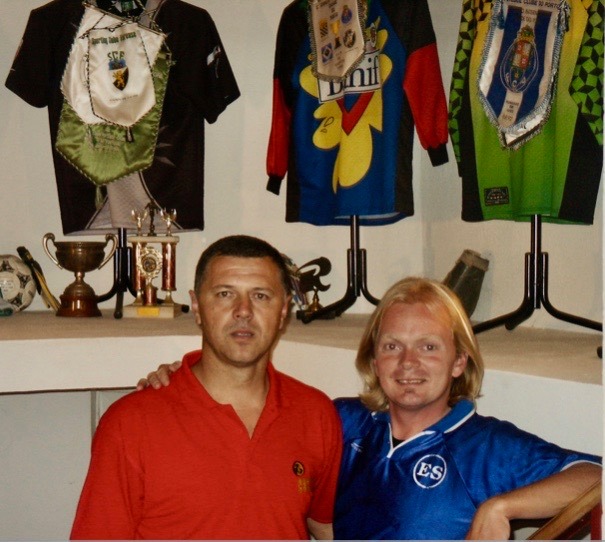
Visiting Zoran Lemajić at his home in Kotor.
Albania was the biggest surprise of the trip.
I had a lot of mixed feelings towards visiting Albania, before I went. The country had recently come out of decades of isolation, where it had been the North Korea of Europe in many ways. The country had a regulation for having a lot of mafia as well. So I was not really sure how it would treat me as a foreign guy traveling by bicycle. But all my negative expectations were made into shame.
It was not that I was treated badly in any way in the other countries that I passed on the trip. But the Albanians were overwhelmingly friendly and curious in the most positive way. You could really feel that this was a country that had longed to meet the outside world for decades. I actually left my camera behind on a bench one day in Albania. A guy came running after me, right away, telling me that I forgot it on the bench.
I had been contacted in advance by an Albanian journalist called Edvin Parruca. He had sent me a long email asking me if I was interested in being interviewed by the TV station that he worked for. A channel called News 24. He was clearly aware that I would possibly be suspicious of such a mail. He sent me all his credentials, so that I could see that he was for real.
He also wrote that I would probably have problems finding a cheap place to stay in Tirana. Back in 2004, there were almost no cheap hotels in Tirana. And not a single backpacker hostel. But he told me that he had a friend called Ilir who would be happy to have me staying at his place. So I moved in to Ilir’s place when I arrived in Tirana.
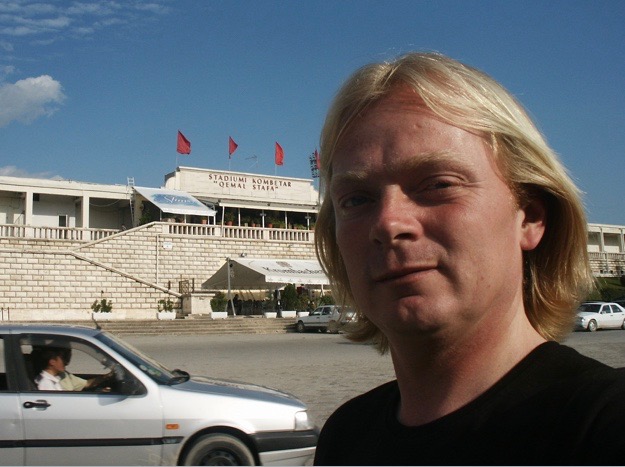
Outside the Qemal Stafa football stadium in Tirana.
In Tirana I built a friendship with Edvin and Ilir that lasts to this day. During my two week stay in Tirana, I also managed to convince them that Tirana was in need of a backpacker hostel. A few months after my visit, they opened up the first backpacker hostel in Albania. A place that is still a thriving business to this day.
Edvin put me on his TV show on News 24. This was really an interesting and surreal experience. I was in a panel discussion that was broadcasted live on TV. In the panel was a well known Albanian sports journalist, which name I have forgotten now. Then there was a guy called Neptun Bajko, who used to coach the Albanian national team. And finally the best Albanian footballer ever. An older guy called Panajot Pano. Neptun Bajko and Panajot Pano did not speak any english.
So the whole thing was done in Albanian language. And I was wearing headphones and had an Albanian translator, who was updating me live on what was being said. Actually, it was more that he told me half of what they said. And then always finished the sentence by saying “And stuff”, when he got tired of translating everything :-).
It was all quite pleasant though and ended up taking more time than planned. Mainly because Neptun Bajko stated that many things in Albania were better under communism. The producer started to sense a little scandal. And asked us to continue a little longer with the discussion. The old footballer Panajot Pano was an extremely friendly and jovial guy. We really hit it off nicely, even if we could not understand each other.
I was told that back in the day he was considered one of the top 10 footballers in the world. Often labelled Little Puskas. But Pano never left Albania. And Albania was as closed as North Korea back then. So he did not have the same international career that he would probably have had, if he had lived in another country. But he will not be forgotten in Albania. When he died in 2010, more than 100 000 Albanians took to the streets to honor their greatest player so far.
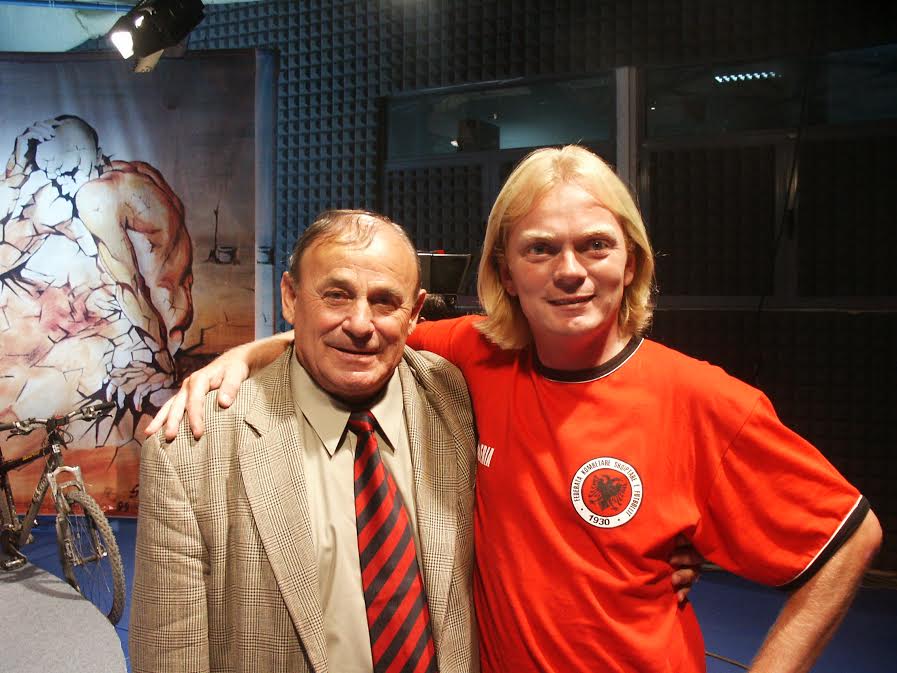
With Panajot Pano at the TV studio.
Then I had my 20 minutes of Albanian fame.
After the News 24 programme, I returned to Ilir’s house, where I was staying. A very beautiful young girl was there waiting for me. Her name was Albana and she told me that she was working for the most popular TV station in Albania called Top Channel. She would like to put me on Albania’s most popular talk show. Right before the game between Albania and Denmark.
We decided to make a little show out of it. So an Albanian friend painted a big Danish flag on my face. I put on an Albanian shirt. And came cycling into the TV studio, while being live on TV.
The interview on Top Channel was not nearly as serious as on News 24. But the entire country was watching. I learned that in the coming days, when I was cycling through Albania. Every single person I met, who could speak English told me that they saw me on TV. I was cheered through Albania as if I was a national hero the following days, as I was cycling towards Macedonia.

Having my “Football make up” done by an Albanian friend.

At the Top Channel TV studio in Tirana.
I had arrived in Tirana a few days before the game between Denmark and Albania. So I had plenty of time to explore the city. And to get to know people. By the time the Danish football team and the fans arrived I was quite settled in Tirana. That gave me a chance to help my fellow Danes a little around Tirana, when they arrived.
Danish television also wanted to do a little thing about my cycling trip. That turned into a friendship with the camera guy from the Danish TV station that still lasts to this day as well.
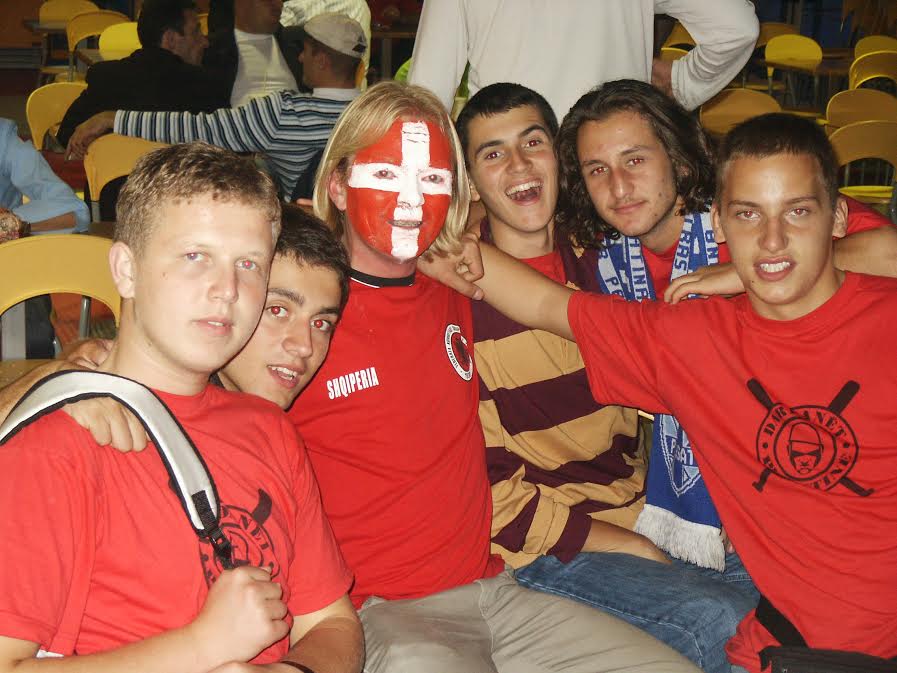
Having a drink with Albanian fans after the game.
After the game in Tirana, which ended with a 2-0 victory for Denmark, I headed east towards Macedonia. Cycling through Albania was really nice. Even if it was quite a climb getting out of Tirana. and an even steeper climb getting up to the mountain lake Ohrid. In Macedonia, I had quite a pleasant ride on quiet roads down to the Greek border.
Cycled past a couple of gypsy settlements that were very sad looking and impoverished. They were nice enough to me though, even if their living conditions were worse than anything I have seen in Brazilian favelas. But really sad that some people still have to live like that in Europe.

Cycling through Macedonia.
Cycling through northern Greece.
Most Europeans associate Greece with islands, beaches and the odd ancient rock. But when you travel in northern Greece, it’s a whole other experience. This is high mountains with shepherds and coldish weather. But it’s a very scenic part of Greece. And I barely saw another foreign visitor, as I was heading towards the Turkish border.
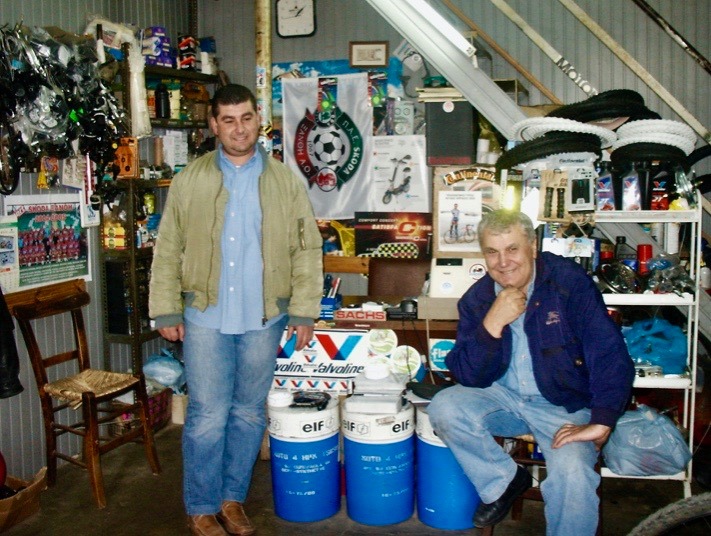
Friendly bicycle mechanic in northern Greece.
Cycling across Turkey is hard work.
I had already cycled in Turkey a couple of times before this trip. So I knew a little about what was awaiting me. I really like Turkey. I have been there several times. At one point spent almost one year working in Turkey as a tour leader and lived with a Turkish girl for a while. It’s a country with a lot of contrast. You have a very westernised and secular society living next door to people who embrace religion and tradition.
Cycling in Turkey is quite hard work though. Unlike the alps, where you tend to cycle in valleys, when you are not having a steep but shirt climb between valleys. Turkey has built the roads different, so that you are going up and down most of the time. You do not really cycle around the mountains in Turkey. You are constantly going up and down mountains. Often on long straight roads that are not winding. and therefore more steep.
On a positive note, drivers tend to be very friendly in Turkey. Constantly cheering me ahead when I am cycling there. And often honking the horn, which can be annoying though. But at least it’s meant to be a friendly gesture.

Northern Turkey is not flat.
Had a few days’ stop in Istanbul. One of my favourite cities on the planet, that I make sure to visit frequently. From Istanbul, I headed up to the Black Sea coast. I cycled as close to the shoreline as I could. But most of the way, the road goes a little inland and is very elevated.
Stopped in cities like Zonguldak, Sinop, Samsun, Trabzon and several other places. The black sea coast is totally different from the Turkish south coast, where many Europeans holiday. It’s quite rainy and not always warm. Because of that it’s also very green though.
The people in the region are clearly influenced by the other countries that surround the Black Sea. There is quite a lot of mix with the former Soviet republics by the Black Sea. So there are both quite a lot of people with blond hair on the Black Sea coast. As well as quite a few with central asian features.
I was a little in a hurry along the black sea coast, as the time between the football game in Tirana and the game in Tbilisi was only 37 days. And I had a little over 3000 kilometres of cycling to do. So no time for longer stops after Istanbul.
Finally in Georgia.
I crossed into Georgia at the beach town of Batumi. I understand that these days, Batumi has become quite a resort town. Back in 2004 it was not there yet. Very nice coastline and beaches. Most of the buildings were in a terrible state. So I cycled directly up to the town Poti.
It was pretty much ramshackle as well. But there was an old hotel, right in the center of town. This was clearly a nice hotel, back in the day. But it was almost entirely closed now. I was not really sure whether they were demolishing it, or rebuilding it. But it had one floor that was kept open yet.
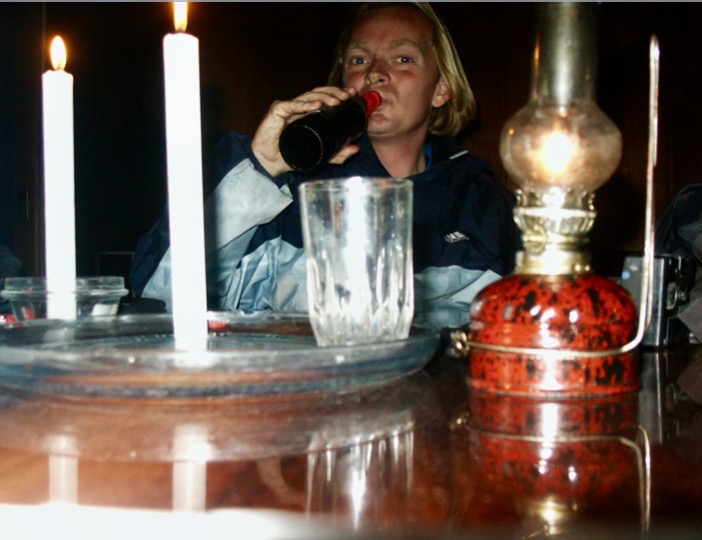
My hotel in Poti had no electricity. But they had candles and an oil lamp for me.
And the few staff members that were left at the hotel showed me to my 5$ room. It was the former presidential suite. It was massive, with several rooms. None of the dogs could lock though. Including the entrance door to the corridor. So I blocked the door for the night with a wooden plank that I found in the corridor. The bathtub was full of water that had been poured into the tub several months ago. So it was in a very brownish state. I did not take a bath that night. The chair and bed springs were a thing of the past in my presidential suite. So I moved the mattress away from the bed and on to the floor. It worked pretty well. For 5$, I actually thought that this was not a bad deal after all.

This is how I locked my hotel door in Poti.
From Poti, I had to go inland in order to reach my final destination Tbilisi. I stayed one night in Kutaisi. Kutaisi has today become a hub for the Hungarian airline Wizzair. So I guess that it has a bit more to offer than it did in 2004. Because back then it took the price as the most run down place I saw on the entire trip. There was not a single road that was paved. Or maybe it was in the past. It looked a little like an armada of B52 planes and bulldozers had been taking care of the town in the past decade back in 2004.
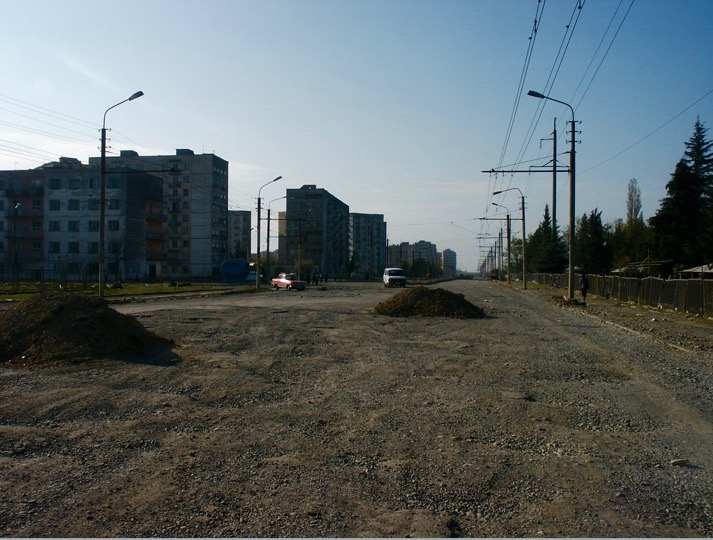
The main street in Kutaisi in 2004.
I stayed in the only modern looking building I could find. A very nice little hotel in the outskirts of town, run by a friendly Russian guy. It was a bit more expensive than what I was used to. But I could not find any other place. But the room was nice. The owner was friendly, even if I think he made more money from gambling and prostitution in that hotel, than from passing tourists like me.
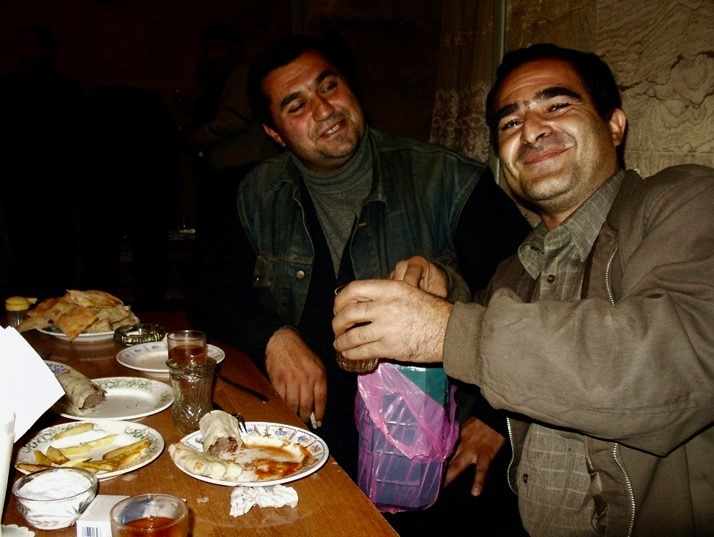
Friendly Georgians serving my home made wine from a jerry can.
I started to climb the Caucasus mountains by the town Zestafoni. My level of fitness was really good, having cycled more than 6000 kilometers. So I was almost flying over the mountains in Georgia.
I had the luck that autumn/winter arrived late that year. The weather was quite nice. even up in the mountains. Stayed one night at a little gas station hotel, where the woman who ran it told me that I was welcome to stay in her room. Had she been 25 years younger and 35 kilos lighter, then I might have said yes. But at least she took my polite refusal with a smile and still made me a nice dinner.

Tbilisi was coming closer.
Arriving to Tbilisi.
My plan was to stop for the night in the town Gori, where Josef stalin was born. But Gori is only 75 kilometres from Tbilisi. When I got there, I started to see the finishing line in Tbilisi. It was only 2pm when I arrived in Gori.
So I decided to cycle into Tbilisi the same day. I was so fit by then, that 150 kilometers per day felt like a walk in the park. Even if I was in the Caucasus mountains.

Having a coffee stop in the middle of nowhere in Georgia.
Arriving in Tbilisi, I could not find a cheap place to stay. I ended up squatting for the night at a refugee camp, at the train station. The people staying there, came from the war town breakaway republic of Abkhazia. They were all very nice and hospitable though. I felt totally safe in my tiny room. It was so incredibly hot and stuffy though, that I decided to stay there for only one night.
Next day I found a homestay. It was run by an elderly lady. She was a retired teacher. and she really wanted to teach me to behave too. She was not happy if i was home late. Every morning I was being lectured that going out late at night only led to bad things.
But the room was pretty nice. and the price and the location was perfect too. So that became my room for the next few days in Tbilisi.
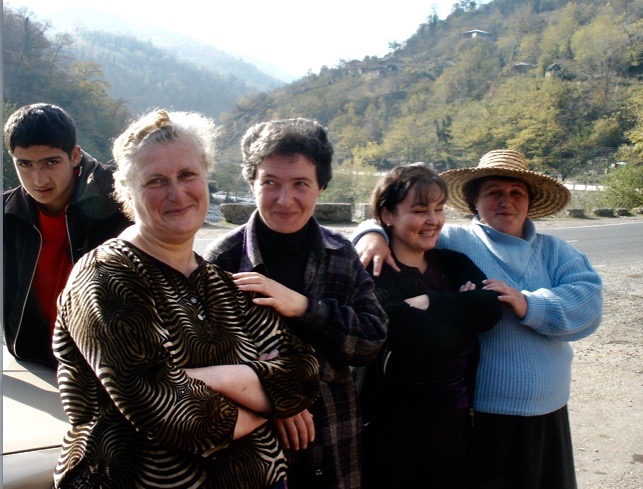
Chatting with some friendly Georgians on the side of the road.
The Danish national football team arrived two days after me. One of the Danish journalists had already asked me to reserve one evening for dinner with a very special guy. I showed up for dinner. And the guy who hosted us was a Georgian guy who was obsessed with everything Danish. Especially the former Danish football international Preben Elkjær Larsen.
His home was like a mini museum for Danish football. With posters and little Danish souvenirs hanging everywhere.
That one of the Danish journalists attending the dinner was a former Danish international (Per Frimann), just made him even more excited. Mamuka Kvaratskhelia, as his name is, has since become a bit of a cult figure for Danes. And whenever there are football encounters between Denmark and Georgia, he is always there to host the Danes in Tbilisi.
I experienced some hooliganism in Tbilisi.
The day before the Denmark vs Georgia game, there was an U21 game between the nations as well. It was being held in a massive stadium that was under reconstruction. There was no admission for the game. So quite a few people showed up, including some frustrated unemployed youth, who were quite rough.
Because the stadium was being rebuilt, it was full of concrete bricks. and when Denmark started winning the game, some of the trouble makers started throwing bricks after the Danish players. The scene was totally insane. But I felt quite safe, even if I was standing right next to some of the brick throwers. So I stayed next to them, until the head of the security came running towards me, screaming that I should run for cover.
I ended up in the middle of the pitch, together with the players. We were all escorted out from the stadium, under police shields. While young guys were hurling bricks and rocks after us. We had a really good laugh about it, once we were safe, in the stadium corridors. And we decided to just take it as yet another interesting travel experience.
The Danish football association was not so easygoing though. and when the big game was on the next day, the small group of Danish fans was not just protected by police. But also by around 200 huge civilian body guards, sitting together with us at the stadium. Considering that we were less than 40 Danes there, 200 civilian body guards, plus police seemed a bit much. But they were all very nice to us.
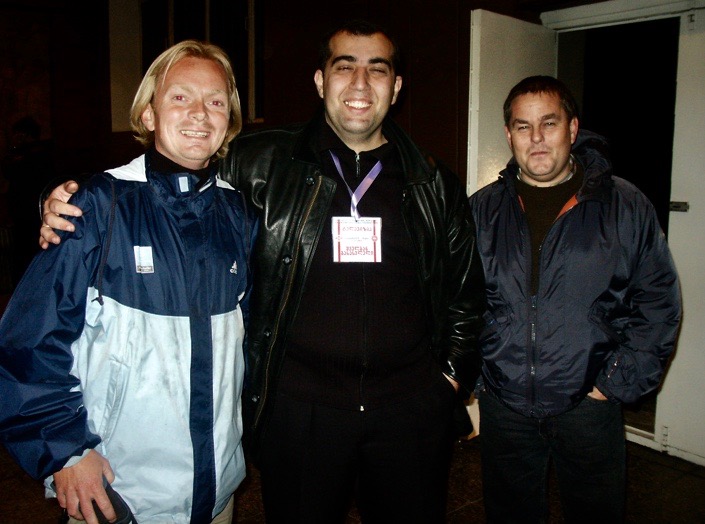
Inside the stadium in Tbilisi, after the brick throwing incident.
The big game ended up as a 2-2 draw, with Denmark having a goal disallowed in overtime. That ended up costing Denmark the world cup qualification in the end. But it was still a great travel experience.
So when I headed back two days after the game, it was after 15 fantastic weeks of cycling 6800 kilometers through 12 countries. So far my longest journey on a bicycle. But that distance will hopefully be beaten soon, as I am not done with this kinda travel.
Hello! Great story and very nicely written. Congratulations! Let me know if Argentina is on your list some day in 5be future. Happy travels!
Having cycled quite a lot in Brazil in the past, Argentina is very high on my list as a new cycling destination.
Very enjoyable and interesting account Claus, especially the TV appearances. I’m glad you managed to get through that tunnel without going back down the pass! I like to swap scarves with opposing fans too and have quite a collection, but luckily I don’t think I’ve ever been given one with far-right symbols!
Really inspirable story! Football and travelling combine very well, I always try to attend some local match when I visit a new country… It is a great way to be integrated on the society!
Pingback: A few things about being a solo tour cyclist traveling the world.
Pingback: Tips and advice for cycling Albania. – Travelling Claus
Pingback: Visiting the abandoned football stadium in Brno. – Travelling Claus